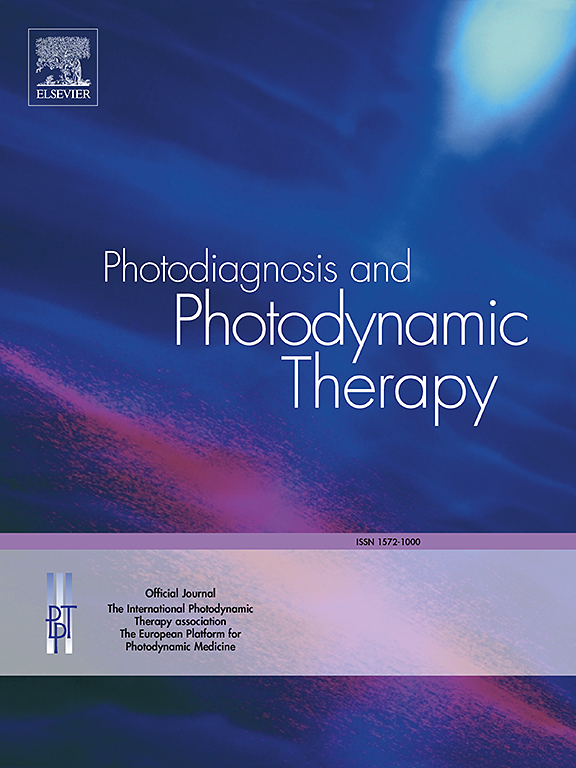纳米碳点作为光敏剂在光动力灭活立克次体中的应用
IF 3.1
3区 医学
Q2 ONCOLOGY
引用次数: 0
摘要
碳量子点(CQDs)在可见光照射下具有促氧化、抗氧化、抗病毒、抗菌和抗癌特性,是一种很有前景的治疗剂。细菌的氧化应激是细菌暴露于蓝光光激发量子点后死亡的主要原因。在此,我们介绍了疏水性碳量子点/聚二甲基硅氧烷纳米复合材料、亲水性柠檬酸量子点以及量子点与亚甲基蓝组合的抗菌活性。我们研究了亲水性和疏水性 CQDs 对蜱传细菌病原体立克次体的抗立克次体效应。在 470 纳米蓝光照射下,CQDs 对立克次体的光动力活性达到 99.66%。将亚甲基蓝与 CQDs 结合使用,可进一步增强对立克次体感染的效果,有效率达到 99.98%。这些结果揭示了 CQDs 的体外抗立克次体特性。对照样本和处理样本的基因组测序分析显示出单核苷酸变异(SNV)。根据片段分析,SNVs 被分配到 rRNA 基因、16S rRNA 基因和 30S rRNA 基因。通过对处理过的样本进行自由贝叶斯分析,在假基因(RSL_RS06070)中检测到一个停止缺失突变,而该突变可能会影响下游基因,包括tsaD、酰基-CoA-去饱和酶、30S核糖体蛋白S6和DUF424家族蛋白。框移突变位于属于应激反应热休克蛋白的 clpB 伪基因中。本文章由计算机程序翻译,如有差异,请以英文原文为准。
Carbon nanodots as photosensitizer in photodynamic inactivation of Rickettsia slovaca
Carbon quantum dots (CQDs) are promising therapeutic agent due to their pro-oxidant, antioxidant, antiviral, antibacterial, and anticancer properties when exposed to visible light irradiation. Oxidative stress in bacteria is the main reason for bacteria death after exposure to blue light photoexcited quantum dots. Herein, we present the antibacterial activities of hydrophobic carbon quantum dots/polydimethylsiloxane nanocomposites, hydrophilic citric acid CQDs, and combinations of CQDs with methylene blue. We investigated the antirickettsial effect of hydrophilic and hydrophobic CQDs against Rickettsia slovaca, a tick-borne bacterial pathogen. Photodynamic activity against on rickettsiae reached 99.66% using CQDs with 470 nm blue light irradiation. Combining methylene blue with CQDs further enhanced the effect on rickettsial infection, achieving 99,98% efficacy. The obtained results reveal the in vitro antirickettsial properties of CQDs. Sequencing analysis on the genomic level of control and treated samples showed single nucleotide variants (SNVs). Based on snippy analysis SNVs were assigned to the rRNA genes, 16S rRNA and 30S rRNA genes. By freebayes analysis in treated samples, a stop-lost mutation was detected in pseudogene (RSL_RS06070), while the possible effect on down-stream genes including tsaD, acyl-CoA-desaturase, 30S ribosomal protein S6 and DUF424 family protein. The frameshift mutation was localized within clpB pseudogene belonging to stress-response heat-shock proteins.
求助全文
通过发布文献求助,成功后即可免费获取论文全文。
去求助
来源期刊

Photodiagnosis and Photodynamic Therapy
ONCOLOGY-
CiteScore
5.80
自引率
24.20%
发文量
509
审稿时长
50 days
期刊介绍:
Photodiagnosis and Photodynamic Therapy is an international journal for the dissemination of scientific knowledge and clinical developments of Photodiagnosis and Photodynamic Therapy in all medical specialties. The journal publishes original articles, review articles, case presentations, "how-to-do-it" articles, Letters to the Editor, short communications and relevant images with short descriptions. All submitted material is subject to a strict peer-review process.
 求助内容:
求助内容: 应助结果提醒方式:
应助结果提醒方式:


